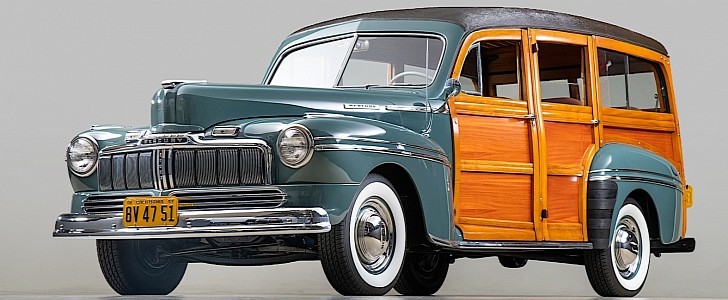Woodies may not be popular today, but there was a time when people associated this type of car with luxury and class. Since that came before woodies turned into the typical suburban American family symbol, few people remember them as such today.
Like it did countless times in its history, Ford was among the first to offer such machines. Starting with the 1930s, it began using wood for a variety of its models across different brands. And Mercury was no exception.
The carmaker’s entry-level brand had something like this thing here to offer back in the 1940s: an eight-passenger station wagon with mahogany panels inside maple and ash framing. It was so luxurious by the time’s standards that it was the most expensive model in the carmaker’s offering, selling for around $2,200 (that would be around $26,000 today).
So interesting was the car for the people of the age that even Mexican government officials wanted them as a display of their status. The one we have here, for instance, was initially ordered and briefly enjoyed by the governor of the Mexican state of Michoacán.
We say briefly because, just like the governor, the car had it rough. According to the info made available by Canepa, the seller of this here Mercury, the car was abandoned in the care of the governor's relatives in 1949.
It’s unclear what happened to it for a long time, but the fact remains that in 1994 it resurfaced in San Luis, being offered as a trade for a 1959 Mercedes 220. The one who got possession of it saw its potential, and a 13-year long restoration process began.
After work was completed, the car somehow made its way across the border, where it now awaits a new owner. We’re told close to $50,000 were invested in it since making the trip north, including $15,000 in chrome plating, but we are not given any hint as to how much the seller wants for it.
The carmaker’s entry-level brand had something like this thing here to offer back in the 1940s: an eight-passenger station wagon with mahogany panels inside maple and ash framing. It was so luxurious by the time’s standards that it was the most expensive model in the carmaker’s offering, selling for around $2,200 (that would be around $26,000 today).
So interesting was the car for the people of the age that even Mexican government officials wanted them as a display of their status. The one we have here, for instance, was initially ordered and briefly enjoyed by the governor of the Mexican state of Michoacán.
We say briefly because, just like the governor, the car had it rough. According to the info made available by Canepa, the seller of this here Mercury, the car was abandoned in the care of the governor's relatives in 1949.
It’s unclear what happened to it for a long time, but the fact remains that in 1994 it resurfaced in San Luis, being offered as a trade for a 1959 Mercedes 220. The one who got possession of it saw its potential, and a 13-year long restoration process began.
After work was completed, the car somehow made its way across the border, where it now awaits a new owner. We’re told close to $50,000 were invested in it since making the trip north, including $15,000 in chrome plating, but we are not given any hint as to how much the seller wants for it.


























